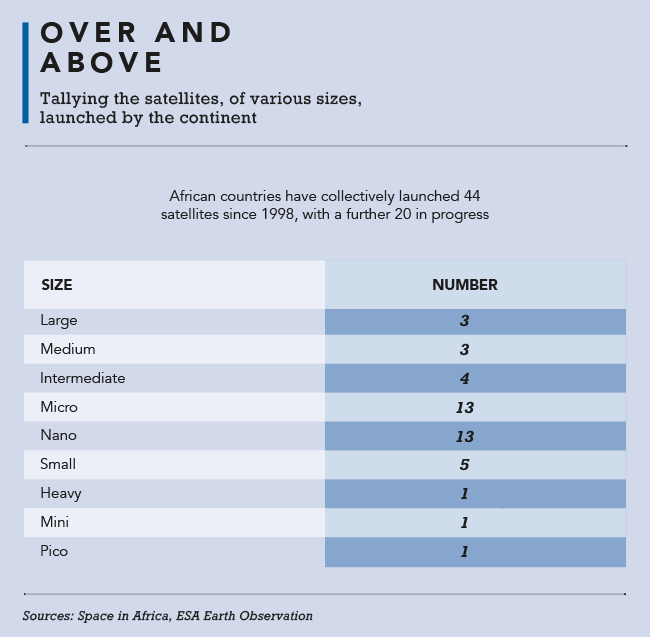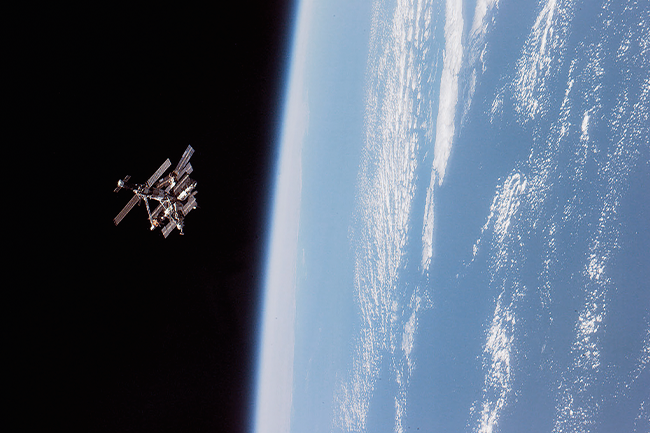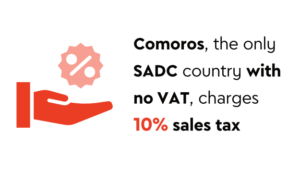Africa launched just one satellite in 2020. It was a Chinese-made, Ethiopian-launched 8.9 kg box named ET-SMART-RSS, and its major mission is to help with flood and disaster preparation. That was it. Just the one, in December.
As opening statements go, that seems pretty underwhelming – yet ET-SMART-RSS launched an exciting future for the African satellite industry. As ET-SMART-RSS rocketed into space, Ethiopia announced plans to use its satellite manufacturing, assembly, integration and testing facilities in Addis Ababa to build and launch another satellite (the country’s third in total), this time for telecoms and broadcasting services.
In March 2021, Tunisia launched its first satellite: Challenge One, an internet of things satellite designed and built entirely in Tunisia. Joining it on board the Soyuz-2 rocket that took off from Kazakhstan’s Baikonur Cosmodrome was Simba, a nanosatellite jointly designed by universities in Israel, Italy and Kenya. That nanosatellite’s sole purpose is to observe wildlife within Kenya’s natural parks, reporting on the movements and migratory patterns of protected species using special sensors placed on animals on the ground.

Then, in June 2021, Mauritius launched its first satellite, hitching a lift aboard the SpaceX Falcon 9 rocket from the Kennedy Space Centre in the US. The Mauritius Imagery and Radiotelecommunication Satellite 1 was built by a team of researchers at the Mauritius Research and Innovation Council, under the guidance of the country’s Ministry of Information Technology Communication and Innovation.
In September, Zimbabwe announced that its first satellite, ZIMSAT-1, would be launched in 2022. An educational and amateur radio-mission cubesat, ZIMSAT-1 is part of the new Zimbabwe National Geospatial and Space Agency, based at the University of Zimbabwe and operated by young Zimbabwean scientists from the country’s Education 5.0 innovation hubs. So while 2020 was a quiet year for Africa’s space projects, don’t for a moment think that nothing is happening.
‘The satellite industry is on the brink of a massive growth phase,’ says Dawie de Wet, group CEO of Q-KON and chief engineer of Twoobii, a Southern African-orientated satellite broadband service. ‘The expected satellite launches in the next decade will be 332% more than in the past decade, with a total expected satellite capacity of 200 Tbps entering the Africa telecommunications market.’
De Wet is excited about the future of African satellites – as well he should be. ‘While the technology developments are happening, the biggest opportunity is in developing the niche and specialist capabilities needed to deliver these satellite services to the market,’ he says. ‘Because satellite is a niche service it falls outside the focus of the main telcos, who rather concentrate resources on the mainstream telco technologies such as 5G, fixed wireless and fibre,’ says De Wet. ’This position creates a strategic advantage for specialist service providers such as Q-KON to lead the service delivery of the next generation of satellite services.’

He points to the latest NewSpace Africa Industry report, published by Space in Africa, which found that the African space industry made revenue of US$7.37 billion in 2019 and is expected to generate more than US$10.24 billion in revenue by 2024. ‘Over 283 private and public companies in 31 African countries operate in the African space and satellite industry, and these companies employ over 44 670 people,’ he says, citing the report. ‘What’s more, 84% of the 283 NewSpace companies covered are downstream companies. Most […] are domiciled in Egypt, Kenya, Nigeria and South Africa, and the majority are bootstrapping their operations.’ Finally, he adds, ‘more NewSpace companies were founded in the last decade, across the industry segment, than in the previous five decades combined’.
South Africa is poised to lead the continent’s satellite market. In 2020 (remember that underwhelming year mentioned earlier?) the South African National Space Agency secured ZAR4.4 billion in investor funding through President Cyril Ramaphosa’s sustainable infrastructure development symposium. SANSA immediately allocated more than ZAR3 billion of that to the design and development of up to six new South African satellites in the next four years.
‘There is a lot of positive momentum created around re-shaping South Africa’s space economy,’ says SANSA CEO Valanathan Munsami. ‘We are seeing a significant growth trajectory in terms of the project pipelines that are coming through from the space economy. Two years ago, we were looking at about ZAR150 million of revenue coming into the system [via an annual Parliamentary grant]. Currently we are sitting on a revenue stream of about ZAR350 million. We are trying to drive the growth as strongly as possible, and if we push forward over the next two years, that revenue stream will be approximately ZAR18 billion.’

Munsami is quick to add, though, that SANSA’s mission is ‘not about implementing all the projects in-house, but rather re-confirming our commitment towards stimulating the space ecosystem and unlocking that potential’.
In Africa, much of that potential lies not 400 km to 650 km above the Earth’s surface (a nanosatellite’s typical orbit), but rather in solving problems on the ground. As Khalid Manjoo, co-founder and chief technical officer of South African start-up Astrofica, recently told CNN, ‘the satellites we put up in space … it’s cool stuff, but it’s not necessarily the end goal. The end goal for Astrofica is to deal with the challenges and problems we would like to solve. They cannot be solved using purely terrestrial systems; they need these critical space-based insights’.
That’s true across industries. As De Wet points out, the application of satellite technology spans a wide spectrum, from broadcast services, government and defence to commercial and private communication services. ‘As a communication medium, satellite has two principal advantages and benefits – the ability to provide service literally everywhere, and also to provide such services at high reliability,’ he says. ‘It can be readily and rapidly deployed and is completely independent of local infrastructure risks such as power load shedding, cable theft or tower infrastructure failures.
‘These characteristics enable attractive business-case models to use satellite in a wide range of applications, including as a business branch back-up service for fibre connections; as a primary service for ATM terminals; as a primary service for merchant point-of-sale terminals; and also business and broadband connectivity to any “off-grid” location,’ he adds. ‘In this case, I mean locations not connected to the national mobile or fixed telecommunications networks.’

Global satellite giant Hughes illustrates this in a recent white paper, where it explored ways of making the internet accessible and affordable for unconnected populations. ‘People in major cities around the world benefit from competitive, high-speed, terrestrial-based internet services, whether it be cable, fibre or cellular 4G LTE. However, once you leave those cities and find yourself where the population density is considerably lower, building out last-mile network access employing terrestrial infrastructure is cost-prohibitive,’ the paper notes. ‘Service providers are wrestling with a stark reality: rolling out infrastructure across long distances only to reach a lower number of potential subscribers cannot be justified. Enter satellite internet, which has already brought broadband access to several million unserved or underserved households and businesses in North and South America, and now beginning to expand to other regions.’
This, the authors explain, is largely because the cost of satellite capacity has plummeted in the past few years, enabling service providers to target home and office customers – ‘even in rural and hard-to-reach places’.
Modern satellite offerings such as HughesNet, which affords download speeds of 25 Mbps, are competitive in performance and cost with those delivered by DSL and cable providers. And as Hughes emphasises, ‘they are both profitable for providers and affordable for those able to pay US$50 per month for service. There now needs to be a new and innovative way to make the service affordable in markets where customers can only afford to pay US$10 to US$20 per month’.
In Africa, those on-the-ground challenges around accessibility and affordability are real and widespread. And as the continent sets the launch sequence on its new array of satellites, there’s hope that those challenges might have a solution up in space.
















